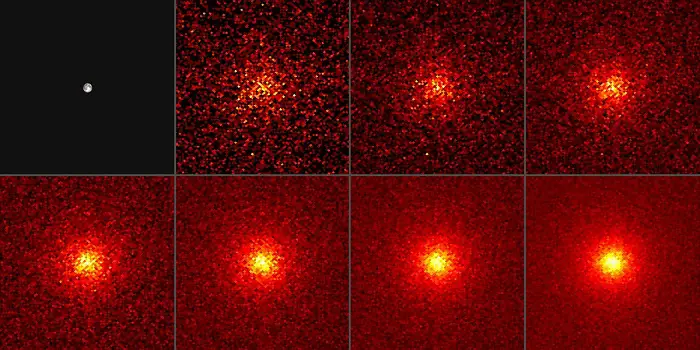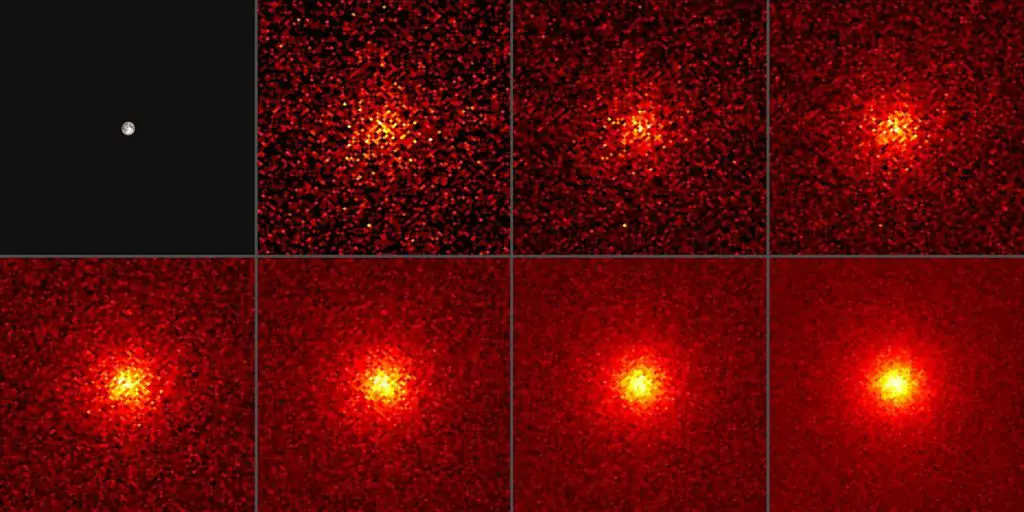Everything the human eye sees exists within a minuscule percentage of the universe. The rest is invisible.
Images shared recently by NASA confirm as much. The pictures, captured through the agency’s Fermi Gamma-ray Space Telescope, show the Moon shining brighter than the Sun!
“Each 5-by-5-degree image is centered on the Moon and shows gamma rays with energies above 31 million electron volts, or tens of millions of times that of visible light,” NASA says in a press release, adding: “At these energies, the Moon is actually brighter than the Sun.”
The agency’s Fermi Gamma-ray Space Telescope is a leading edge space observatory. NASA sent the telescope, along with its entire apparatus, into orbit in 2008.
The telescope opens a window into an unexpected universe.

Why is the Night Sky Dark?
Until recently, astronomers were stuck on a question that any child asks at one point or another. Why is the night sky dark?
If the infinite universe has an infinite numbers of stars, our evenings should be bright with starlight.
Astronomers eventually got the answer. They figured out that the universe doesn’t go on forever — but it is expanding, whooshing outward in all directions.
So our universe, even with its delirium of stars, doesn’t have enough to flood the night sky with starlight!
What we do see pales in comparison to what is out there, beyond the limits of the human eye.
To measure light and energy in the universe, astronomers need another kind of vista. They need powerful telescopes stationed in space, where their instruments have an unobstructed view, free from contamination by Earth’s atmosphere.
For this, they turn to NASA’s Fermi space telescope.
An Unexpected Universe
NASA, along with an international team of scientists, designed the Fermi space telescope to measure gamma rays. Like visible light, gamma rays are made of photons, but are invisible to the human eye.
Gamma-rays are a form of electromagnetic radiation. We also call them radio waves, infrared radiation, ultraviolet radiation, X-rays, and microwaves.
A spectacular gamut of processes emits gamma-rays throughout the universe. Neutron stars and pulsars, exploding supernova, and the mysterious regions around black holes all produce massive gamma-ray bursts.
A Full Moon, Always!
Mario Nicola Mazziotta and Francesco Loparco of Italy’s National Institute of Nuclear Physics in Bari, have been analyzing the Moon’s gamma-ray glow.
They hope to learn — in the course of their analysis — about another type of radiation from space: cosmic rays.

“Cosmic rays are mostly protons accelerated by some of the most energetic phenomena in the universe, like the blast waves of exploding stars and jets produced when matter falls into black holes,” says Mazziotta.
The particles are electrically charged, and sensitive to magnetic fields. Since the Moon has no magnetic fields, even low-energy cosmic rays can reach its surface. This turns the Moon into a kind of particle detector, moving along an orbit around our planet.
When cosmic rays strike, they interact with the powdery surface of the Moon to produce gamma-ray emissions. The Moon absorbs most of these gamma rays, but some of them escape.
“Seen at these energies, the Moon would never go through its monthly cycle of phases and would always look full,” says Loparco.
Gamma-ray astronomy opens us to new ways to view our universe. What more can we expect to see in the future?






